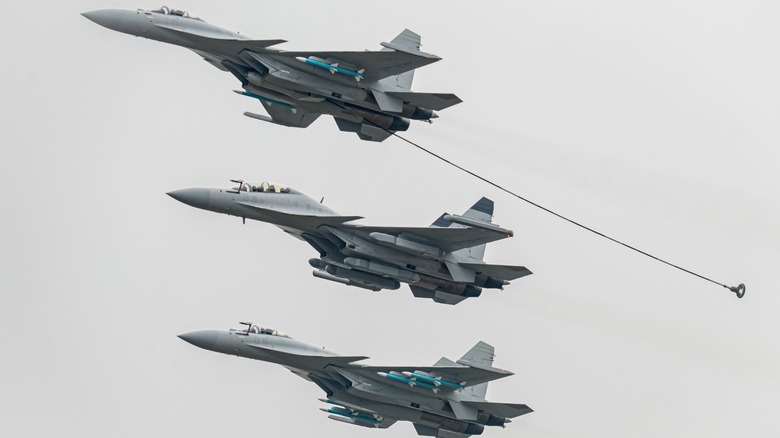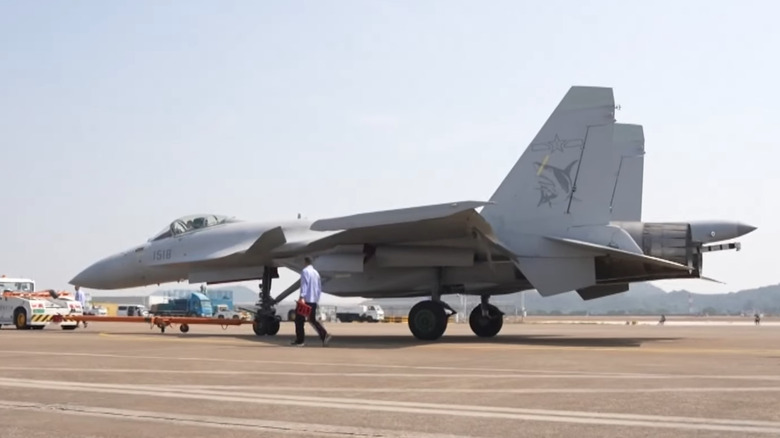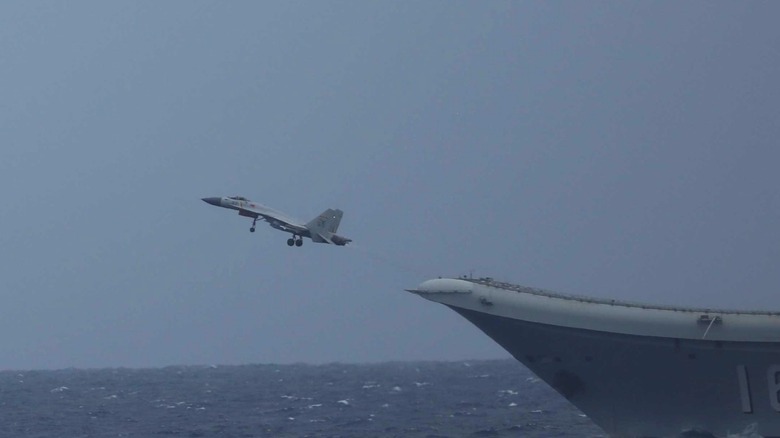J-15T: How Capable Is China's Carrier-Based Fighter Jet
The J-15T is China's upgraded carrier-based fighter, built for aircraft carriers that support CATOBAR launches — catapult-assisted takeoff but arrested recovery – like the Fujian, which is described as unsinkable. Earlier J-15 models were built for short takeoff but assisted recovery (STOBAR), relying on carriers with ski-jump ramps, which have their own advantages. That change alone boosts the jet's effectiveness because catapults allow the aircraft to take off with heavier payloads, meaning more fuel and more weapons.
To withstand the stress from a CATBOAR launch, the J-15T features a reinforced front landing gear with a longer, heavier-duty oleo strut and a launch bar to. This version also integrates better avionics, radar, and cockpit technology. The most obvious visual cue is the new light gray radome, reshaped to house an AESA radar. That radar boosts tracking capabilities and allows the jet to use newer weapons like the PL-15 and PL-10 air-to-air missiles.
China's previous carriers, Liaoning and Shandong, still use ski-jump ramps, which the J-15T can also utilize, giving the People's Liberation Army Navy (PLAN) flexibility across its growing fleet. That's important because it gives the J-15T immediate utility while China transitions to more advanced ships and aircraft. Simply put, this isn't a prototype or placeholder; it's operational and built to extend the reach of China's carrier air wings now.
Built from a proven platform, but still evolving
At its core, the J-15T is a heavily modified descendant of the Russian Su-33 Flanker. The airframe has been Chinese-made for years, but it has historically depended on Russian engines. That changed with the J-15T, which has since been powered by domestic WS-10 turbofans; another sign that China's aerospace sector is maturing. Using homegrown engines also removes supply chain vulnerabilities and boosts long-term support and upgrade flexibility.
The J-15T adds multiple changes beyond just the landing gear. It's equipped with an updated cockpit, including a wide-angle heads-up display and physical control bars for the pilot to hold during launches. Modifications to the flight control system may also address stability problems that affected earlier J-15s. The newer design also likely incorporates parts of the J-11D's more reliable fly-by-wire system.
Despite the improvements, this is still a large, non-stealthy fighter jet that will serve as companion to the eventual F-35 copy, the stealthy J-35. But the upgrades give it staying power. As a multirole fighter, the J-15T can perform fleet defense and maritime missions with far more confidence than its predecessor.
Why the J-15T still matters in China's carrier strategy
The J-15T may not be stealthy, but it plays a critical role in China's expanding naval strategy. With at least 14 jets confirmed in low-rate production and more likely on the way, this variant is China's stopgap and workhorse until the J-35 fully arrives. It gives the PLAN a mature, multirole carrier aircraft that can fly from any of the nation's three carriers.
The J-15T also lays the foundation for more advanced roles. Two-seat variants like the J-15D and J-15S are already in the pipeline. The D model focuses on electronic warfare, similar to the U.S. Navy's EA-18G Growler, while the S version may eventually serve as a strike and trainer platform. This layered approach mirrors the U.S. Navy's own Super Hornet-based fleet mix.
Until China's stealth carrier wing is fully online, the J-15T is the PLAN's best shot at carrier-based airpower with reach, teeth, and reliability. It's not the end goal, but it's a big step forward.


